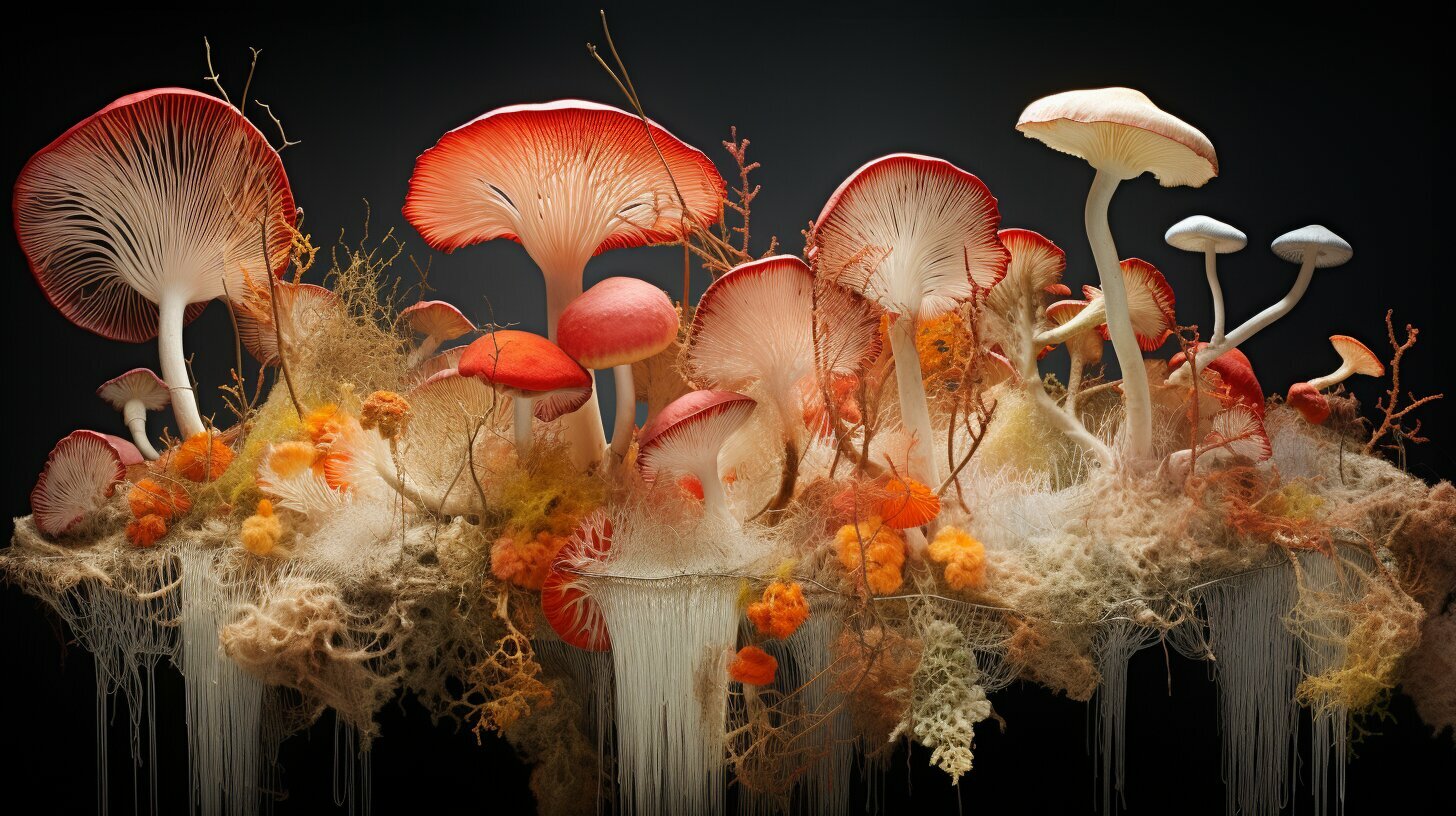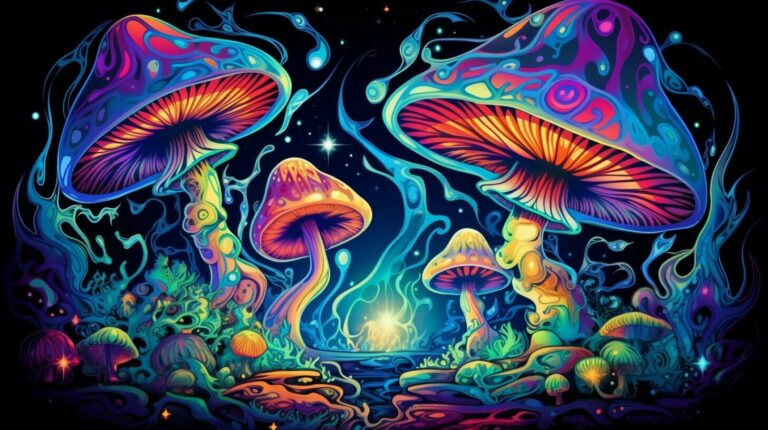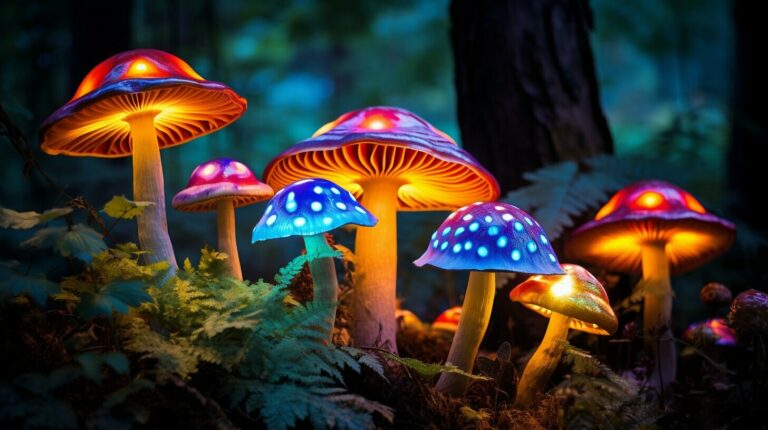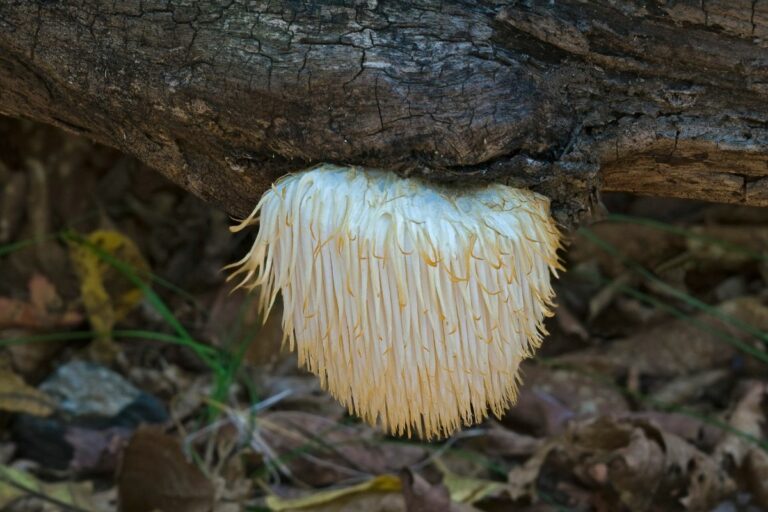Welcome to the fascinating world of mushroom anatomy! In this article, we will explore the intricate structure and essential functions that make mushrooms unique organisms.
Mushroom anatomy refers to the various parts of a mushroom and their functions. The main parts of a mushroom include the cap, gills or pores, spores, ring, stem, volva, basal bulb, and mycelium.
The cap is the visible part of the mushroom and can vary in shape and size. It is the most recognizable feature of different mushroom species and plays a crucial role in their identification.
The gills or pores are located on the underside of the cap and are responsible for producing spores. Spores are the reproductive cells of the mushroom and play a vital role in spreading and propagating new fungal growth.
The ring is a membrane that surrounds the stem and helps protect the gills or pores as the mushroom grows. It acts as a barrier and prevents damage to the spore-producing structures.
The stem connects the cap to the ground and can vary in length and thickness. It provides support for the mushroom and enables it to reach optimal conditions for growth.
The volva is a protective cup-like structure that surrounds the base of some mushrooms. It acts as a barrier and protects the young fruiting body from external factors.
The basal bulb is a chunky structure found at the bottom of mature mushrooms. It serves as an indicator of maturation and is important in distinguishing different stages of mushroom development.
The mycelium is a network of hyphae that connects and reproduces underground. It supports the growth of the fruiting body and plays a vital role in nutrient transfer and symbiotic relationships with other organisms.
Understanding the anatomy of mushrooms is important for identifying and appreciating their unique characteristics and potential health benefits. It allows us to delve deeper into the complexity of these organisms and their role in ecosystems.
Key Takeaways
- Mushrooms have various parts, including the cap, gills or pores, spores, ring, stem, volva, basal bulb, and mycelium.
- The cap is the visible part of the mushroom and varies in shape and size.
- Gills or pores are responsible for spore production.
- The ring acts as a protective barrier for the spore-producing structures.
- The stem provides support and connects the cap to the ground.
The Cap: The Visible Identity
Table of Contents
The cap of a mushroom is like its face, the feature that helps distinguish one species from another. Let’s delve into the captivating world of mushroom caps!
The shape and size of mushroom caps can vary greatly among different species. Some caps are flat and wide, while others are conical or bell-shaped. Certain mushrooms have caps that are rounded, while others have caps that are more elongated. The size of the cap can range from just a few centimeters to several inches in diameter.
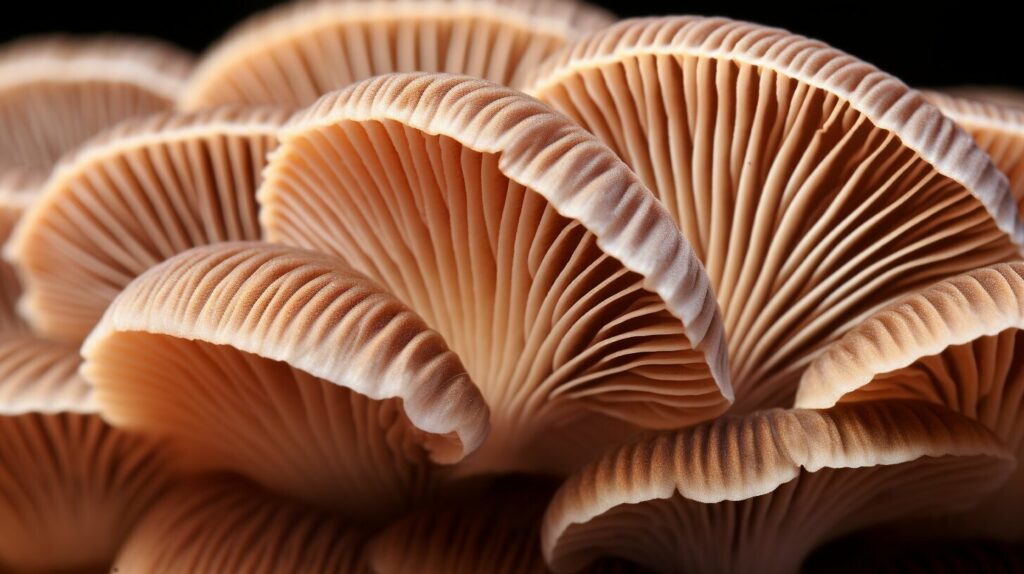
A mushroom cap is composed of the pileus, which is the top surface, and the hymenium, which contains the gills or pores. The pileus can be smooth, wrinkled, or covered in scales, depending on the species. The color of the cap can also vary widely, ranging from white to shades of brown, yellow, red, or even blue.
The gills or pores of a mushroom are located on the underside of the cap. Gills are thin, blade-like structures that radiate from the center towards the outer edge of the cap. They are responsible for producing and releasing the mushroom’s spores. Pore-bearing mushrooms, on the other hand, have tiny holes or pores instead of gills. These pores also serve as channels for spore dispersal.
Table 1: Examples of Mushroom Cap Shapes and Sizes
| Species | Cap Shape | Cap Size (Diameter) |
|---|---|---|
| Agaricus bisporus | Convex | 4-6 cm |
| Amanita muscaria | Conical | 10-20 cm |
| Cantharellus cibarius | Trumpet-like | 2-10 cm |
Understanding the diverse shapes and sizes of mushroom caps is crucial for accurate identification. It allows mushroom enthusiasts and foragers to differentiate between edible and poisonous varieties. So, the next time you stumble upon a mushroom, take a closer look at its cap, and you might just uncover the hidden beauty within!
Gills or Pores: Spore Producers
Beneath the cap lies a secret world of spore production. Get ready to uncover the fascinating gills or pores of mushrooms! These intricate structures, located on the underside of the cap, are responsible for the production and dispersal of spores, which are essential for the reproduction of mushrooms.
Mushroom gills are thin, blade-like structures that radiate out from the stem. They are most commonly found in the Agaricales order, which includes popular edible mushrooms such as the button and portobello mushrooms. The gills act as a spore factory, producing and releasing countless microscopic spores into the surrounding environment. These spores then have the potential to germinate and develop into new fungal growth.
On the other hand, certain mushrooms, like boletes and polypores, do not have gills but instead possess pores. Mushroom pores are small openings found on the underside of the cap. These pores are lined with basidia, specialized cells that produce and discharge spores. As the mushroom matures, the spores accumulate within the pores, waiting for the right conditions to be released into the air.
Exploring Mushroom Gills and Pores
To better understand the complex structure and function of mushroom gills and pores, let’s take a closer look:
| Gills | Pores |
|---|---|
| – Thin, blade-like structures | – Small openings |
| – Radiate out from the stem | – Found on the underside of the cap |
| – Common in Agaricales order | – Found in boletes and polypores |
| – Spore production and dispersal | – Spore production and accumulation |
Both gills and pores play a crucial role in the life cycle of mushrooms. They ensure the survival and propagation of these fascinating organisms, allowing them to spread their spores far and wide. Understanding the structure and function of these spore producers is key to identifying different mushroom species and appreciating the complex world that lies beneath the cap.

Mushroom spores are the reproductive cells that hold the potential for new fungal growth. They are tiny, lightweight, and easily carried by air currents, water, or even animals. Once they land in a suitable environment, they can germinate and give rise to the mycelium, the underground network of hyphae that eventually forms the fruiting body of mushrooms.
Spores come in a variety of shapes, sizes, and colors, which can be crucial for identifying different mushroom species. By observing the unique characteristics of spores under a microscope, mycologists can decipher the intricate world of fungi and classify mushrooms into their respective taxonomic groups.
“The extraordinary beauty and diversity of mushroom spores never cease to amaze me. Each species has its own distinct spore shape and ornamentation, creating an endless array of patterns under the microscope.” – Dr. Mycologist
- Spores are reproductive cells essential for mushroom propagation.
- They can be dispersed by air, water, or animals.
- Different mushroom species have distinct spore shapes and sizes.
- Microscopic examination helps in accurate mushroom identification.
So, the next time you come across a mushroom, take a moment to appreciate the hidden beauty within its gills or pores. These spore producers are a testament to the intricate and fascinating world of mushroom anatomy and the remarkable ways in which fungi ensure their continued existence.
Stay tuned for the next section, where we’ll delve into another intriguing aspect of mushroom anatomy!
Spores: The Reproductive Cells
Spores, the magical building blocks of new mushroom life, are a crucial part of the reproduction process. Let’s dive into the microscopic world of mushroom spores! These tiny cells are responsible for the creation of new fungal growth and play a vital role in the life cycle of mushrooms.
Produced in abundance, mushroom spores are released from the gills or pores of the cap. They are microscopic and appear in various shapes, sizes, and colors depending on the mushroom species. Spores are dispersed into the environment by wind, water, or through the movement of animals.
Did you know? Mushroom spores are incredibly diverse and can survive in harsh conditions for extended periods, awaiting the right environment for germination and growth. They can withstand extreme temperatures, UV radiation, and even be transported across long distances.
To better understand the anatomy of mushroom spores, take a look at the following table:
| Characteristics | Description |
|---|---|
| Shape | Varies from round to elliptical, cylindrical, or needle-like |
| Size | Typically ranges from 3 to 20 micrometers |
| Color | Varies greatly and can be white, brown, black, yellow, or even purple |
| Surface | Smooth, rough, spiky, or textured |
The unique characteristics of mushroom spores, such as their shape, size, and color, are essential for their identification and classification. These microscopic wonders contribute to the vast diversity of mushrooms found in nature.
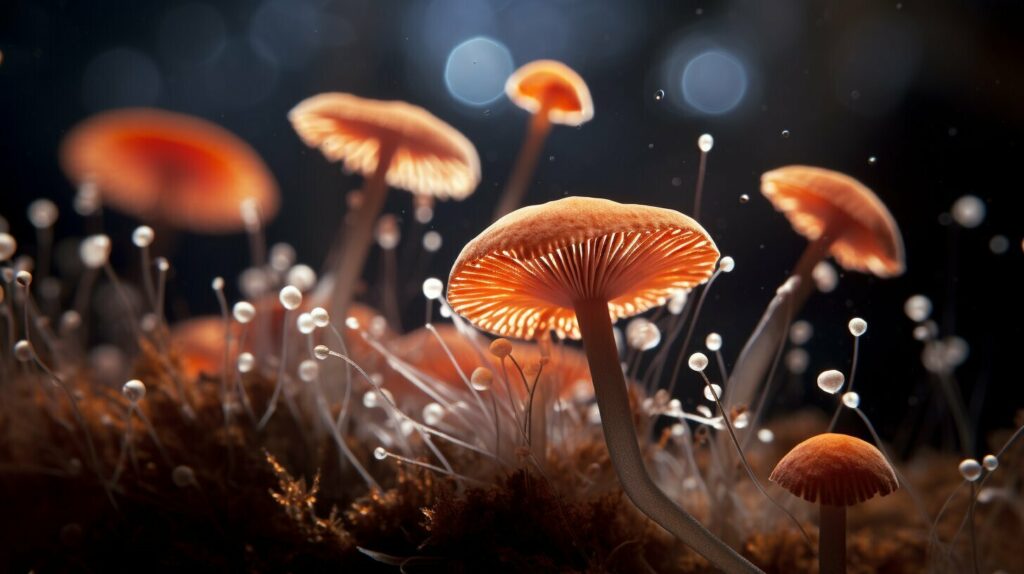
The total number of spores produced by a single mushroom can range from thousands to millions, making them a significant force in fungal reproduction.
Understanding the world of mushroom spores brings us closer to appreciating the complexity and beauty of these fascinating organisms. Next time you encounter a mushroom, take a moment to ponder the incredible journey that began with a tiny spore, paving the way for the growth of a magnificent fungal fruiting body.
The Ring: A Protective Membrane
Like a guardian shield, the ring plays a vital role in protecting the mushroom’s delicate gills or pores as it reaches for the sky. Let’s explore the significance of this curious mushroom feature!
The ring, also known as the annulus, is a fascinating and important part of a mushroom’s anatomy. It is a membrane that surrounds the stem, forming a protective barrier for the gills or pores as the mushroom grows. This unique feature can be seen in various mushroom species and serves as a distinguishing characteristic.
Functionally, the ring plays a crucial role in the life cycle of the mushroom. As the cap expands and grows, the ring remains attached to the stem, acting as a shield to protect the developing gills or pores from damage or interference. It ensures that the spore-producing structures can mature undisturbed, allowing the mushroom to reproduce successfully.
To fully appreciate the role of the ring, one must understand its formation. As the mushroom develops, the ring originates from the partial veil, a thin membrane that initially covers and protects the gills or pores. Over time, the partial veil stretches and moves upwards, forming the ring around the stem. Eventually, the partial veil breaks, leaving the ring as a remnant, while the gills or pores become exposed.
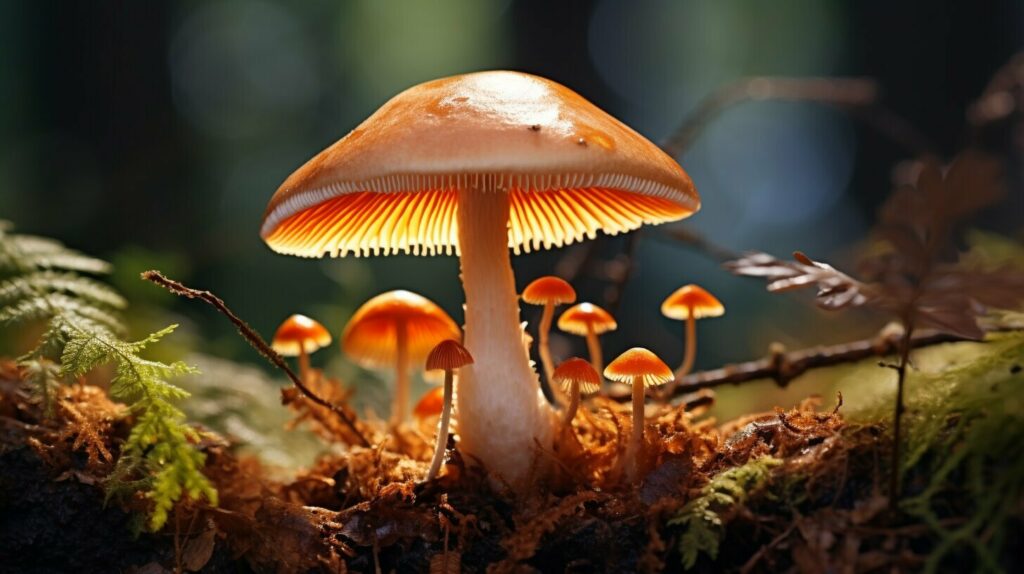
| Type of Ring | Description |
|---|---|
| Membranous Ring | A thin, translucent ring that appears as a delicate membrane encircling the stem. |
| Evanescent Ring | A ring that is initially present but disappears as the mushroom matures. |
| Persistent Ring | A ring that remains intact even as the mushroom matures, often appearing as a solid band around the stem. |
In conclusion, the ring is more than just a curious feature on a mushroom—it serves a protective purpose in safeguarding the gills or pores during growth and reproduction. Its presence, along with other anatomical characteristics, can aid in the accurate identification of different mushroom species. Let’s continue our exploration of mushroom anatomy by discovering the fascinating world of mushroom stems!
The Stem: Support and Connection
The stem acts as the sturdy pillar that elevates the cap above the ground and connects it to the hidden world beneath. Discover the strength and importance of the humble mushroom stem!
As an essential part of mushroom anatomy, the stem provides crucial support for the cap. Varying in length and thickness, mushroom stems come in different shapes and sizes, reflecting the diversity of mushroom species. Some stems are slender and elongated, while others are short and stout. This structural variation not only adds to the visual appeal of mushrooms but also serves specific purposes in their growth and reproductive processes.
Table:
| Stem Characteristics | Functions |
|---|---|
| Length and thickness | Provides stability and structural integrity to the mushroom |
| Connection to the mycelium | Links the cap to the underground network of mycelium, enabling nutrient absorption and transfer |
| Attachment site for the volva | Secures and protects the volva, a cup-like structure surrounding the base of some mushrooms |
The mushroom stem not only supports the cap but also plays a vital role in connecting the above-ground fruiting body to the mycelium below. The mycelium is a complex network of thread-like structures called hyphae, which are responsible for nutrient absorption and decomposition. The stem acts as a bridge, allowing the mycelium to transfer nutrients and energy to the mushroom.
Understanding the intricacies of mushroom anatomy, including the significance of the stem, can enhance our appreciation for these fascinating organisms. Next time you stumble upon a mushroom, take a moment to admire the strength and connection provided by its stem, symbolizing the hidden world beneath our feet.
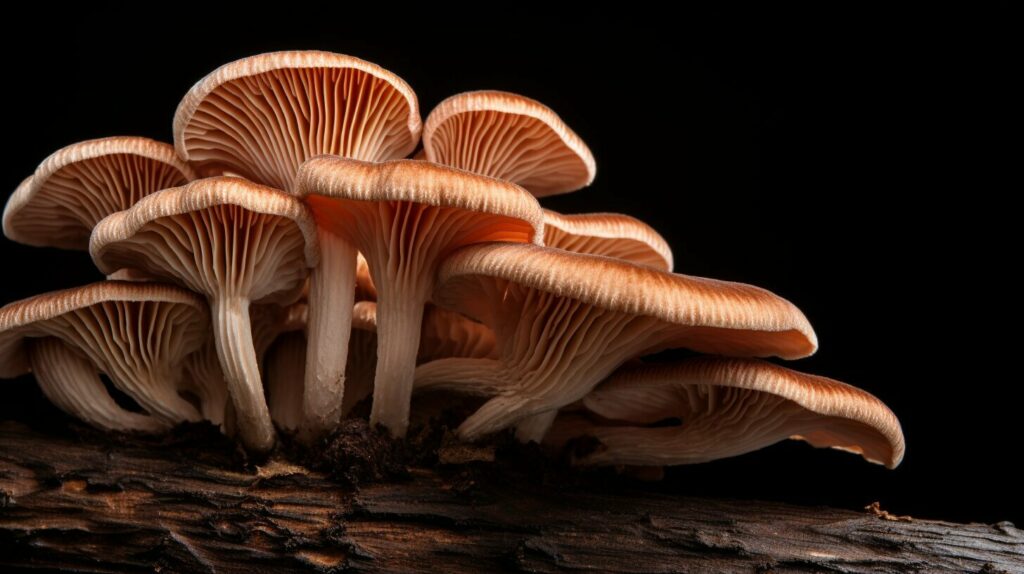
“The mushroom stem acts as a strong support system for the cap, ensuring it stands tall against the elements.”
The Volva: A Cup-Like Protector
Nestled at the base of particular mushrooms, the volva acts as a guardian, providing protection and an essential clue to a mushroom’s identity. Let’s unravel the secrets of this unique mushroom feature!
The volva is a cup-like structure that surrounds the base of certain mushrooms, resembling a protective membrane. It is formed during the early stages of the mushroom’s growth and remains attached to the base throughout its life cycle. The volva’s appearance can vary in shape, color, and texture, offering valuable insights into the identification and classification of different mushroom species.
Not only does the volva serve as a protective barrier, shielding the delicate mycelium and the developing fruiting body, but it also plays a crucial role in spore dispersal. As the mushroom matures, the volva ruptures, releasing spores into the environment. This mechanism ensures the propagation and spread of fungal growth, contributing to the dispersion of mushrooms in their natural habitats.
“The volva is not only a key feature for mushroom identification, but it also serves as a window into the intricate life cycle of fungi,” says Dr. Olivia Collins, a renowned mycologist. “By examining the shape, color, and texture of the volva, we can gain insights into a mushroom’s habitat, ecological associations, and potential medicinal properties.”
Understanding the significance of the volva is essential for both amateur and professional mushroom enthusiasts. By recognizing and documenting the unique characteristics of the volva, researchers and foragers can contribute to the ever-evolving knowledge of mushroom taxonomy and ensure the accurate identification of species. Moreover, the study of volvas can provide valuable information about the ecological roles of mushrooms and their potential benefits in various fields, including medicine, agriculture, and environmental conservation.
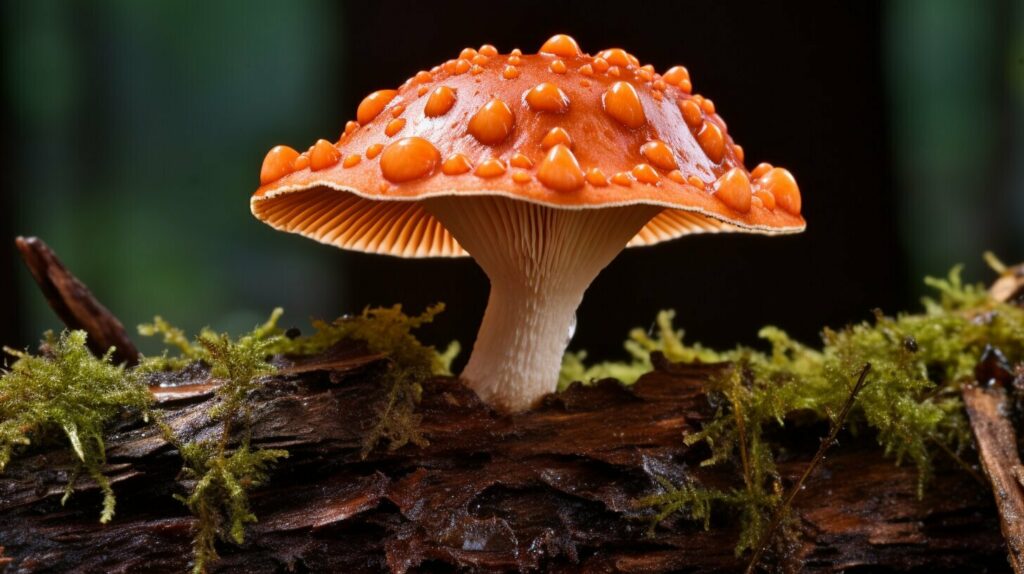
The volva, a cup-like structure surrounding the base of certain mushrooms, serves as a protective membrane and an important clue for identifying different species. Its appearance can vary, providing valuable insights into mushroom classification. The volva acts as a guardian, shielding the delicate mycelium and assisting in spore dispersal. By understanding the volva’s characteristics, researchers and enthusiasts can contribute to the study of mushroom taxonomy and gain knowledge about the ecological roles and potential benefits of fungi.
| Volva Benefits | Significance |
|---|---|
| Protects mycelium and fruiting body | Preserves mushroom’s delicate structure |
| Aids in species identification | Key clue for mushroom classification |
| Assists in spore dispersal | Contributes to fungal propagation |
| Provides insights into habitat and medicinal properties | Window into mushroom’s life cycle and potential benefits |
The Basal Bulb: Maturation Sign
As mushrooms mature, a distinct bulb emerges at their base, signaling readiness for the next stage of their journey. Let’s delve into the mysterious world of the basal bulb!
The basal bulb, also known as the volva remnant, is a chunky structure found at the bottom of mature mushrooms. It serves as an essential indicator of maturation and plays a significant role in distinguishing different mushroom stages. This bulb-like structure is formed during the early development of the mushroom and remains attached to the base as it grows.
One fascinating feature of the basal bulb is its unique appearance. It often looks like a swollen sac or an eggshell fragment surrounding the mushroom’s stem. The size, shape, and color of the basal bulb can vary between mushroom species, contributing to the diversity and identification of different fungi.
| Mushroom Species | Basal Bulb Characteristics |
|---|---|
| Agaricus bisporus (Button Mushroom) | Small, whitish to yellowish bulb |
| Amanita muscaria (Fly Agaric) | Conspicuous, white or yellow bulb covered in patches |
| Morchella esculenta (Morel Mushroom) | Conical, hollow bulb with pits and ridges |
The basal bulb provides valuable insights into the life cycle of mushrooms. Its presence signifies the maturity of the fruiting body, indicating that the mushroom is ready to release its spores into the environment. This is an essential reproductive phase for mushrooms, contributing to their ability to propagate and spread.
The development of the basal bulb is closely linked to the growth and reproductive processes of mushrooms. Understanding its characteristics and significance can aid in the identification of mushroom species and enhance our appreciation of the intricate world of fungi.
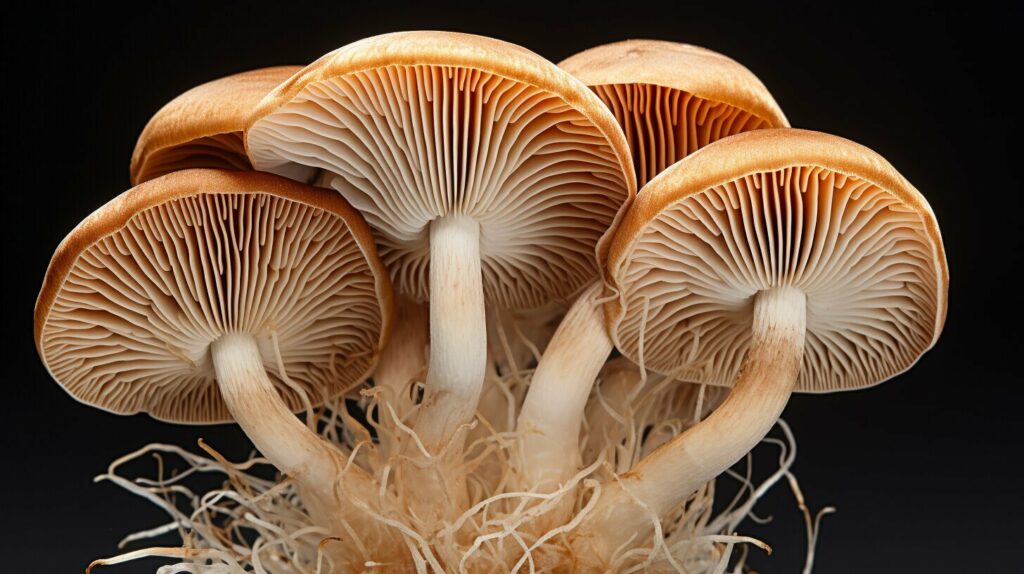
As mushrooms mature, a distinct basal bulb emerges at their base, indicating their readiness for the next stage of their life cycle. The basal bulb, or volva remnant, is a chunky structure that remains attached to the mushroom’s stem. It varies in appearance, size, and color across different mushroom species. The presence of the basal bulb signifies the maturity of the mushroom and its readiness to release spores for reproduction. Understanding the characteristics and importance of the basal bulb enhances our understanding of mushroom anatomy and aids in species identification.
The Mycelium: Underground Network
Hidden beneath our feet, a vast network of interconnected threads weaves its way through the soil, supporting the life and growth of mushrooms. Let’s uncover the secrets of the remarkable mycelium!
The mycelium, often referred to as the “vegetative” part of the mushroom, plays a crucial role in the lifecycle of these fascinating organisms. Composed of thin, branching structures called hyphae, the mycelium extends its reach underground, searching for nutrients and moisture. It forms a complex web that connects with other organisms, including plants, in a symbiotic relationship.
The mycelium acts as a nutrient highway, transferring essential substances between different parts of the mushroom and its surroundings. Through its intricate network, it absorbs nutrients from the soil and transfers them to the fruiting body, which is the visible part of the mushroom. This process not only supports the growth and development of mushrooms but also facilitates nutrient exchange with other plants, promoting biodiversity and ecological balance.
| Mushroom Mycelium |
|---|
 |
Furthermore, the mycelium plays a vital role in decomposing organic matter. It breaks down complex compounds, such as dead plant material or fallen leaves, and converts them into simpler forms that can be readily absorbed by other organisms. This process not only recycles nutrients but also enhances soil fertility, supporting the growth of new plants and contributing to the overall health of ecosystems.
In conclusion, mushroom mycelium is a fascinating underground network that connects mushrooms with their environment. It serves as a nutrient highway, facilitates symbiotic relationships, promotes biodiversity, and contributes to the decomposition and recycling of organic matter. Understanding the role of mycelium in mushroom anatomy is essential for appreciating the complexity and importance of these incredible organisms.
Exploring the Complexity of Mushroom Anatomy
Throughout this journey into the intricate world of mushroom anatomy, we have unraveled the mystique behind their various parts and functions. Understanding mushroom anatomy is the key to unlocking the beauty and potential benefits of these fascinating organisms.
The cap, as the most visible part of a mushroom, comes in different shapes and sizes, serving as a distinct identifying feature. The gills or pores, located on the underside of the cap, play a crucial role in spore production, ensuring the mushroom’s reproductive success.
Speaking of spores, these tiny cells hold the key to mushroom reproduction. They are responsible for spreading and propagating new fungal growth, ensuring the survival of the species. The ring, a protective membrane encircling the stem of certain mushrooms, shields the delicate gills or pores as the mushroom grows, safeguarding their vital function.
The stem, connecting the cap to the ground, provides support for the mushroom and establishes its connection to the vast underground network of mycelium. This mycelium, consisting of a complex network of hyphae, not only supports the growth of the mushroom fruiting body but also facilitates nutrient transfer and connects with other organisms, including plants.
Additionally, we encountered the volva, a cup-like structure that acts as a protector for the base of specific mushrooms, and the basal bulb, a chunky structure that serves as an indicator of maturation. These distinctive features assist in identifying different mushroom species and understanding their life cycle.
By delving into the intricate anatomy of mushrooms, we gain a deeper understanding and appreciation for their unique characteristics and potential health benefits. So, next time you stumble upon a mushroom in the forest or at the grocery store, take a moment to admire its enchanting design and marvel at the fascinating world hidden beneath its cap.
FAQ
Q: What is mushroom anatomy?
A: Mushroom anatomy refers to the various parts of a mushroom and their functions.
Q: What are the main parts of a mushroom?
A: The main parts of a mushroom include the cap, gills or pores, spores, ring, stem, volva, basal bulb, and mycelium.
Q: What is the cap of a mushroom?
A: The cap is the visible part of the mushroom and can vary in shape and size.
Q: What are gills or pores in mushrooms?
A: The gills or pores are located on the underside of the cap and are responsible for producing spores.
Q: What are spores in mushrooms?
A: Spores are the reproductive cells of the mushroom.
Q: What is the ring in mushrooms?
A: The ring is a membrane that surrounds the stem and helps protect the gills or pores as the mushroom grows.
Q: What is the stem of a mushroom?
A: The stem connects the cap to the ground and can vary in length and thickness.
Q: What is the volva in mushrooms?
A: The volva is a protective cup-like structure that surrounds the base of some mushrooms.
Q: What is the basal bulb in mushrooms?
A: The basal bulb is a chunky structure at the bottom of a mature mushroom.
Q: What is the mycelium in mushrooms?
A: The mycelium is a network of hyphae that connects and reproduces underground. It supports the growth of the fruiting body and can also connect plants and transfer nutrients.

